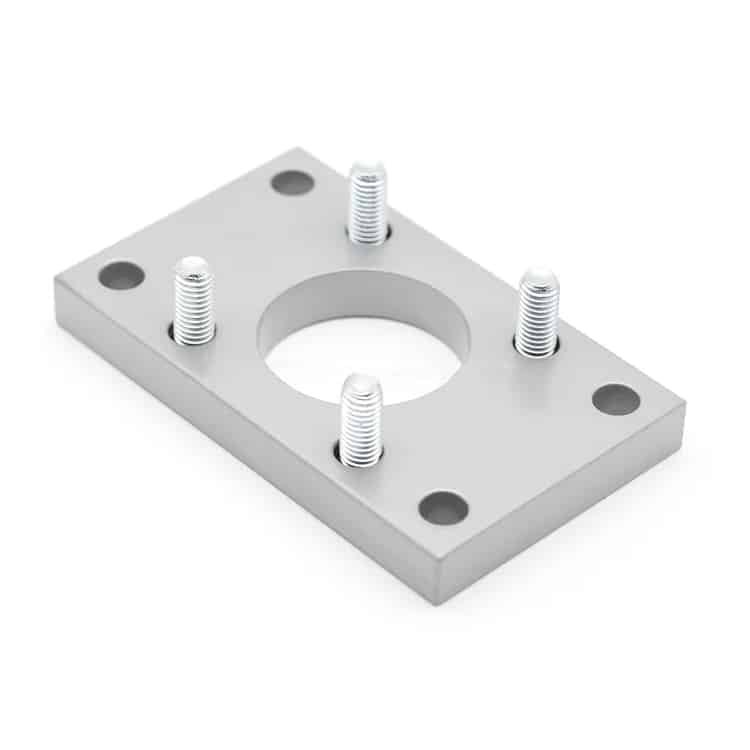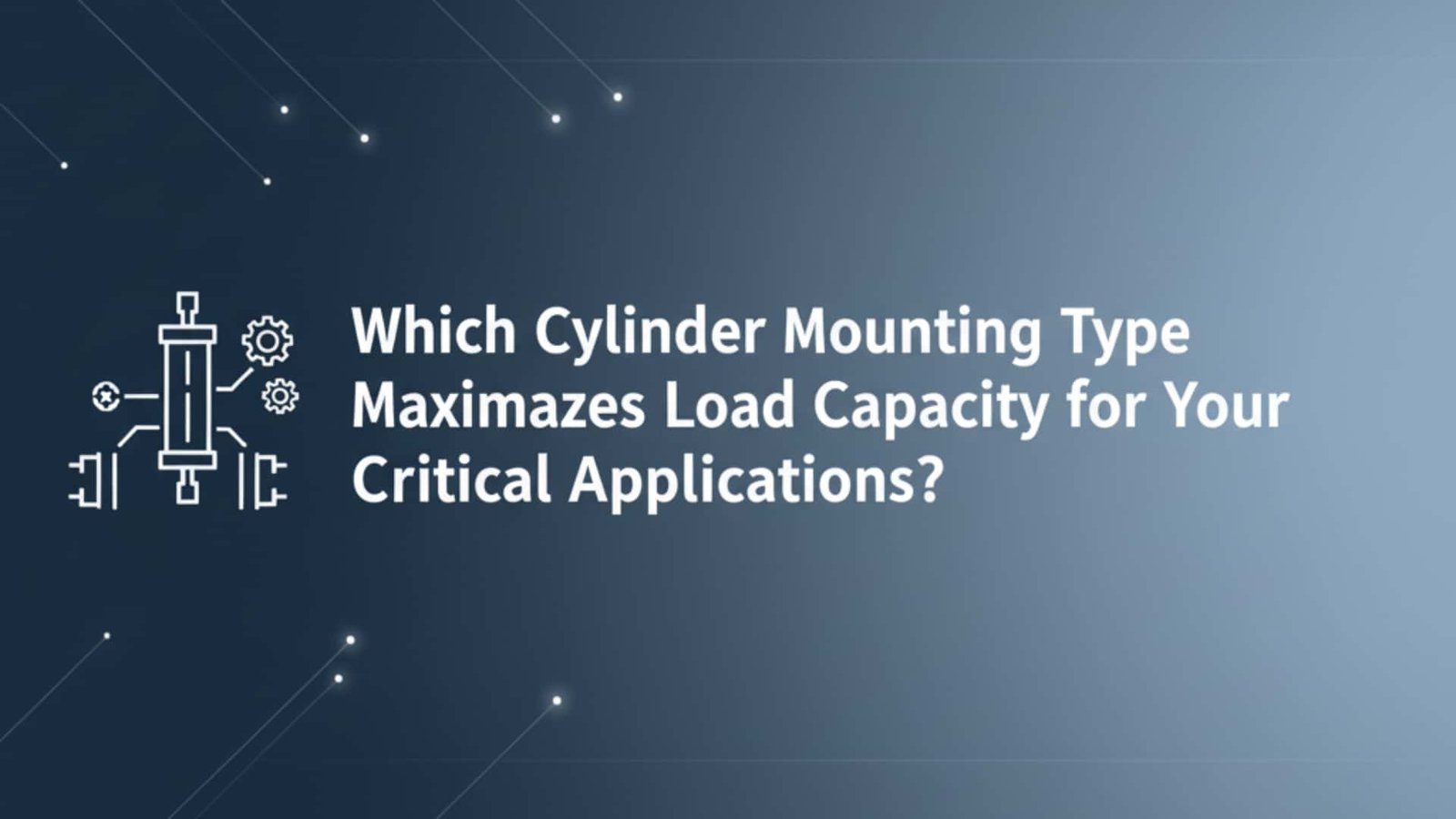
Engineers lose over $1.2 million annually due to premature cylinder failures caused by improper mounting selections, with 45% choosing fixed mounts for dynamic loads that require pivot mounts, while 38% select lightweight trunnion mounts for heavy-duty applications where they fail within months instead of years. ⚠️
Типът на монтаж на цилиндъра пряко определя капацитета на натоварване, като фиксираните монтажи могат да се справят с аксиални натоварвания до 15 000 N, шарнирните монтажи поддържат 8 000 N с възможност за странично натоварване, шарнирните монтажи се справят с 12 000 N в компактни пространства, а фланцовите монтажи осигуряват капацитет над 20 000 N за тежки приложения, поради което правилният избор е от решаващо значение за предотвратяване на скъпоструващи повреди и постигане на максимална надеждност на системата.
Just last month, I worked with Jennifer, a mechanical engineer at a steel processing plant in Pennsylvania, whose cylinders were failing every 6 weeks due to странично зареждане1 on fixed mounts. After switching to our Bepto pivot-mounted cylinders, her system has operated flawlessly for over 4 months with zero downtime. 🏭
Съдържание
- What Are the Key Differences Between Fixed and Pivot Cylinder Mounts?
- How Do Trunnion and Flange Mounts Compare for Heavy-Duty Applications?
- Which Mounting Configuration Provides Maximum Load Capacity for Your Application?
- How Do You Calculate and Optimize Load Distribution Across Different Mount Types?
What Are the Key Differences Between Fixed and Pivot Cylinder Mounts?
Understanding the fundamental differences between fixed and pivot mounts enables engineers to select the optimal configuration for specific load conditions and application requirements.
Fixed mounts provide maximum axial load capacity up to 15,000N with rigid attachment but cannot accommodate side loading or misalignment, while pivot mounts offer 8,000N capacity with ±5° angular flexibility and excellent side load resistance, making pivot mounts essential for applications with dynamic loading or potential misalignment issues that would destroy fixed mount cylinders.

Fixed Mount Characteristics
Load Capacity Advantages:
- Максимален axial force2: Up to 15,000N depending on cylinder size
- Rigid connection: No flex or movement under load
- Simple installation: Direct bolt-on mounting
- Икономичност: Lower manufacturing and installation costs
Critical Limitations:
- Zero side load tolerance: Any lateral force causes immediate failure
- No misalignment accommodation: Perfect alignment required
- Концентрация на напрежението3: All forces transmitted directly to mount points
- Limited application scope: Only suitable for pure axial loading
Pivot Mount Advantages
Flexibility Benefits:
- Angular accommodation: ±5° typical range
- Side load resistance: Handles lateral forces effectively
- Misalignment tolerance: Compensates for installation variations
- Dynamic capability: Adapts to changing load directions
Спецификации на капацитета на натоварване:
| Отвор на цилиндъра | Fixed Mount Max Load | Pivot Mount Max Load | Капацитет на странично натоварване |
|---|---|---|---|
| 32 мм | 3,000N | 2,000N | 800N |
| 50 мм | 6,000N | 4,000N | 1,500N |
| 80 мм | 12,000N | 8,000N | 3,000N |
| 100 мм | 15,000N | 10,000N | 4,000N |
Критерии за подбор на заявления
Choose Fixed Mounts When:
- Pure axial loading only
- Perfect alignment guaranteed
- Maximum load capacity required
- Оптимизирането на разходите е приоритет
- Static applications with no movement
Choose Pivot Mounts When:
- Any possibility of side loading
- Dynamic applications with movement
- Installation alignment uncertain
- Long-term reliability critical
- Maintenance access is limited
How Do Trunnion and Flange Mounts Compare for Heavy-Duty Applications?
Trunnion and flange mounts serve different heavy-duty applications, with each offering unique advantages for specific industrial requirements and space constraints.
Trunnion mounts provide 12,000N capacity in compact installations with 360° rotation capability and excellent vibration resistance, while flange mounts deliver maximum load capacity exceeding 20,000N with rigid mounting for the heaviest applications, making trunnion mounts ideal for space-constrained dynamic applications and flange mounts perfect for maximum-load stationary installations.
Trunnion Mount Specifications
Design Advantages:
- Compact footprint: Minimal space requirements
- 360° rotation: Complete rotational freedom
- Балансирано натоварване: Forces distributed evenly
- Устойчивост на вибрации: Excellent dynamic performance
Load Capacity by Size:
| Отвор на цилиндъра | Trunnion Max Load | Moment Capacity | Обхват на въртене |
|---|---|---|---|
| 40 мм | 4,000N | 150 Nm | 360° |
| 63 мм | 8,000N | 400 Nm | 360° |
| 80 мм | 12,000N | 650 Nm | 360° |
| 100 мм | 15,000N | 1,000 Nm | 360° |
Flange Mount Capabilities
Heavy-Duty Features:
- Maximum load capacity: 20,000N+ for large bores
- Твърд монтаж: No deflection under load
- Multiple bolt patterns: Distributed load attachment
- Custom configurations: Tailored to specific requirements
Съображения за инсталиране:
- Space requirements: Larger mounting footprint needed
- Alignment critical: Precise installation required
- Достъп за поддръжка: Plan for service requirements
- Foundation strength: Adequate support structure essential
Bepto Mount Solutions
At Bepto, we offer comprehensive mounting solutions:
- Standard configurations for common applications
- Custom mount designs for special requirements
- Load calculation support for optimal selection
- Указания за инсталиране for maximum performance
Robert, a project manager at a automotive assembly plant in Michigan, needed maximum load capacity in a tight space. Our Bepto trunnion-mounted cylinders provided 12,000N capacity while fitting in half the space of his previous flange-mounted solution. 🚗
Which Mounting Configuration Provides Maximum Load Capacity for Your Application?
Selecting the optimal mounting configuration requires analyzing load types, directions, and magnitudes to match cylinder capabilities with application demands.
Maximum load capacity is achieved through proper mount selection: flange mounts for pure axial loads up to 25,000N, pivot mounts for combined axial/side loads up to 10,000N/4,000N, trunnion mounts for rotational applications up to 15,000N, and custom mounts for specialized requirements exceeding standard capacities, with proper selection preventing 90% of premature cylinder failures.
Рамка за анализ на натоварването
Load Type Classification:
- Осеви натоварвания: Forces along cylinder centerline
- Side loads: Forces perpendicular to cylinder axis
- Моментни натоварвания4: Rotational forces creating bending
- Динамични натоварвания: Varying forces during operation
- Shock loads: Sudden impact forces
Mount Selection Matrix
| Load Condition | Recommended Mount | Max Capacity | Основни предимства |
|---|---|---|---|
| Pure Axial | Fixed/Flange | 25,000N | Максимална здравина |
| Axial + Side | Pivot | 10,000N + 4,000N | Load flexibility |
| Ротация | Тризъбец | 15,000N | 360° movement |
| Многопосочен | Потребителски | Променлива | Tailored solution |
Capacity Optimization Strategies
Load Distribution Techniques:
- Multiple mount points: Distribute forces across structure
- Reinforced connections: Strengthen critical attachment points
- Load path analysis: Optimize force transmission
- Фактори за безопасност: Include appropriate design margins
Performance Enhancement:
- Proper alignment: Maximize load capacity utilization
- Quality fasteners: Use appropriate bolt grades and torques
- Редовна проверка: Monitor for wear and damage
- Preventive maintenance: Replace components before failure
Решения по поръчка
When Standard Mounts Are Insufficient:
- Extreme load requirements: Beyond standard capacities
- Unique space constraints: Non-standard configurations
- Special environmental conditions: Corrosive or extreme temperatures
- Integration requirements: Matching existing equipment
How Do You Calculate and Optimize Load Distribution Across Different Mount Types?
Proper load calculation and distribution analysis ensures optimal mount selection and prevents premature failures through systematic engineering analysis.
Load distribution calculation involves analyzing axial force (F_axial), side force (F_side), and moment (M = F_side × L) components, with фактори на безопасност5 of 2-4 applied to working loads, and mount selection based on combined loading using the formula: Load_ratio = √[(F_axial/F_max)² + (F_side/F_side_max)² + (M/M_max)²] ≤ 1.0 for safe operation.
Load Calculation Methodology
Basic Force Analysis:
- Identify all forces: Catalog every load source
- Determine directions: Map force vectors accurately
- Calculate magnitudes: Quantify maximum expected loads
- Apply safety factors: Include appropriate margins
- Verify mount capacity: Ensure adequate strength
Насоки за коефициента на безопасност
Препоръчителни коефициенти на безопасност:
| Тип приложение | Фактор на безопасност | Обосновка |
|---|---|---|
| Static loads | 2.0 | Basic reliability |
| Dynamic loads | 3.0 | Fatigue consideration |
| Shock loads | 4.0 | Защита от удар |
| Критични приложения | 5.0 | Maximum reliability |
Load Distribution Optimization
Multi-Mount Systems:
- Load sharing: Distribute forces across multiple points
- Redundancy: Backup capacity for critical applications
- Подравняване: Ensure equal load distribution
- Наблюдение: Track individual mount performance
Bepto Engineering Support
Our technical team provides comprehensive load analysis:
- Free load calculations for your specific applications
- Mount selection guidance на базата на доказани методологии
- Custom design services for special requirements
- Проверка на изпълнението through testing and analysis
Sarah, a design engineer at a packaging equipment manufacturer in Ohio, was unsure about load calculations for her new machine. Our Bepto engineering team provided detailed analysis and recommended pivot mounts that have operated perfectly for 18 months with zero failures. 📦
Заключение
Proper cylinder mounting selection based on load capacity requirements prevents costly failures and maximizes system reliability, with each mount type offering specific advantages for different application demands.
FAQs About Cylinder Mounting Types and Load Capacities
Q: What happens if I exceed the rated load capacity of my cylinder mount?
Exceeding rated capacity leads to premature failure through stress concentration, fatigue cracking, or catastrophic mount failure. Always include appropriate safety factors and verify actual loads don’t exceed 80% of rated capacity for reliable long-term operation.
Q: Can I convert from fixed mount to pivot mount on existing cylinders?
Most cylinders can be retrofitted with different mount types, though this may require machining modifications or adapter plates. Contact our technical team to evaluate conversion feasibility and provide appropriate mounting solutions for your specific cylinder model.
Q: How do I determine if my application has side loading that requires pivot mounts?
Any application where the load path isn’t perfectly aligned with the cylinder centerline creates side loading. This includes applications with flexible connections, thermal expansion, or any mechanism that could cause angular misalignment during operation.
Q: What’s the difference between working load and maximum load capacity?
Working load is the normal operating force your application generates, while maximum capacity is the ultimate strength of the mount. Your working load should never exceed 50-80% of maximum capacity to ensure reliable operation with appropriate safety margins.
Q: How often should I inspect cylinder mounts for load-related wear?
Inspect mounts monthly for high-load applications, quarterly for standard applications, and annually for light-duty applications. Look for cracks, deformation, loose fasteners, or unusual wear patterns that indicate overloading or misalignment issues.
-
Learn about the causes and effects of side loading (lateral force) on linear actuators and why it leads to premature failure. ↩
-
Understand the fundamental difference between axial forces that act along an object’s axis and radial (or side) forces that act perpendicularly. ↩
-
Explore how geometric features can cause stress to build up in a component, leading to fatigue and failure under load. ↩
-
Discover the principles of moment loads, which are rotational forces that create bending stress in mechanical components. ↩
-
Read a guide on the importance of safety factors and how they are used in engineering to account for uncertainties and prevent failures. ↩


